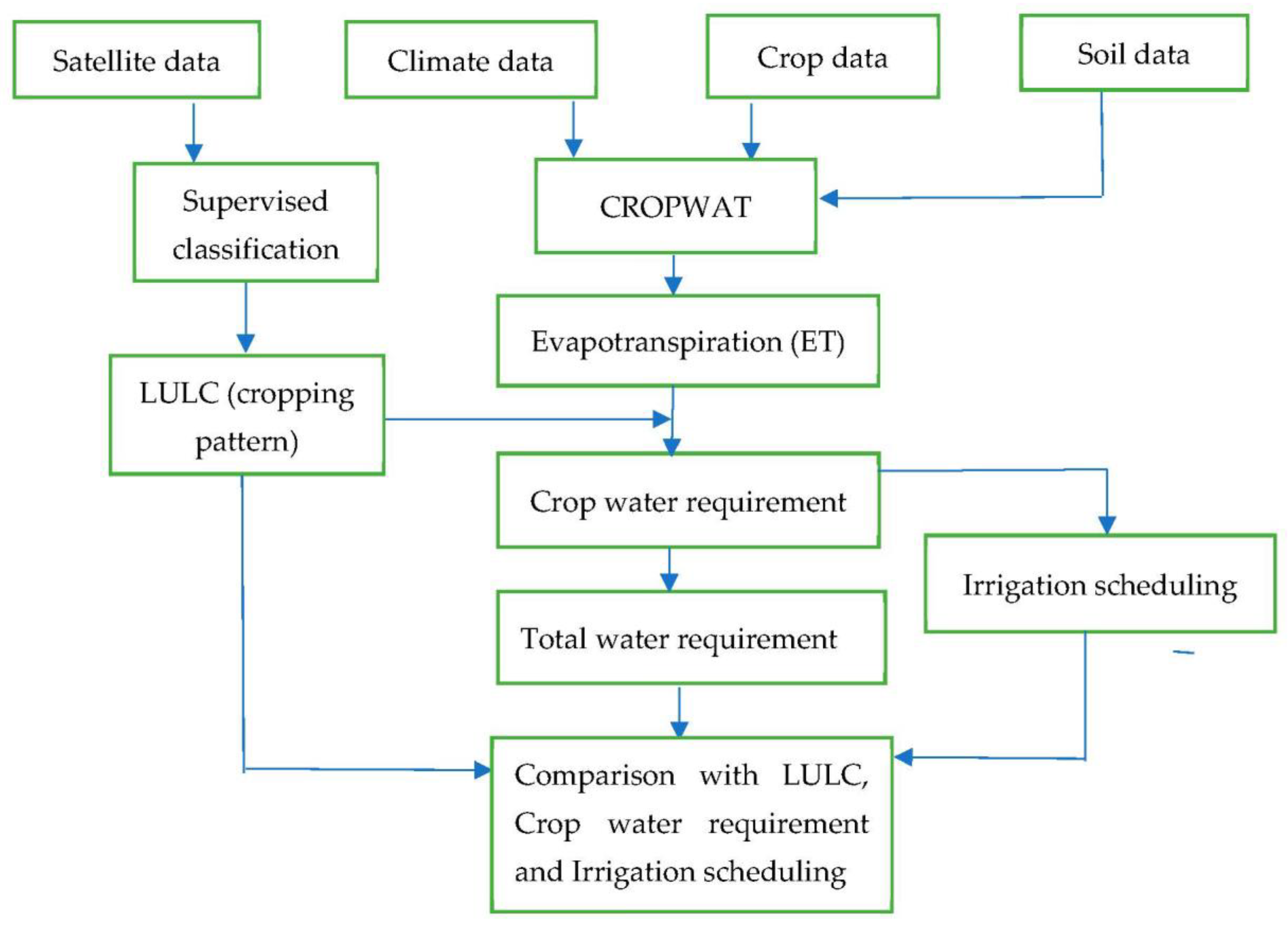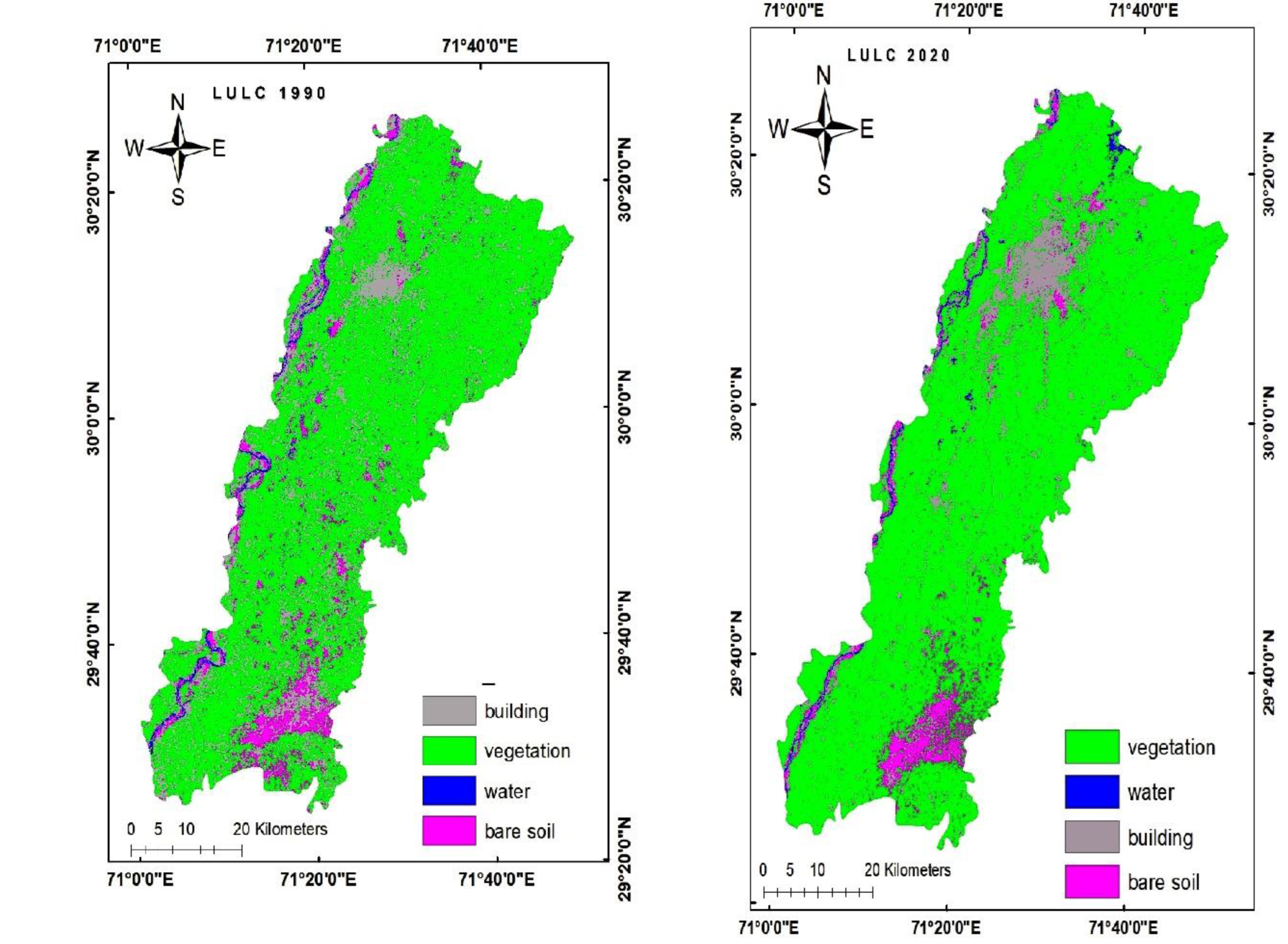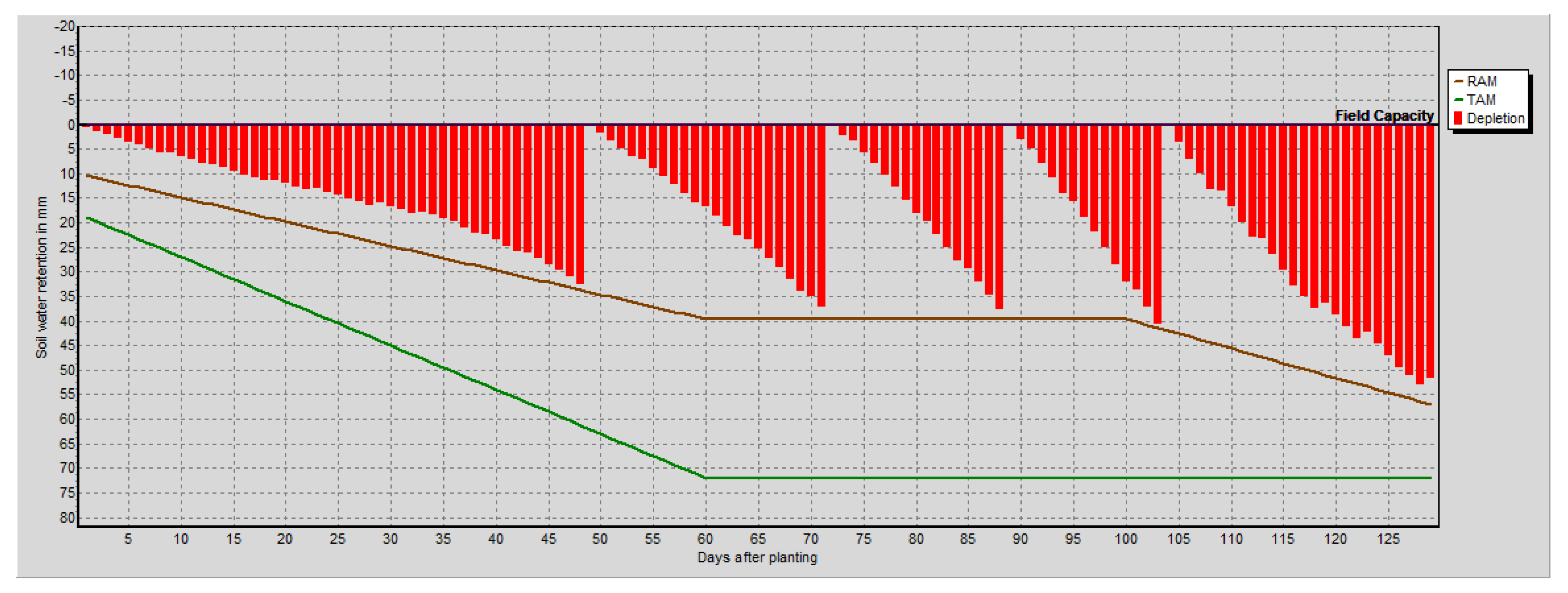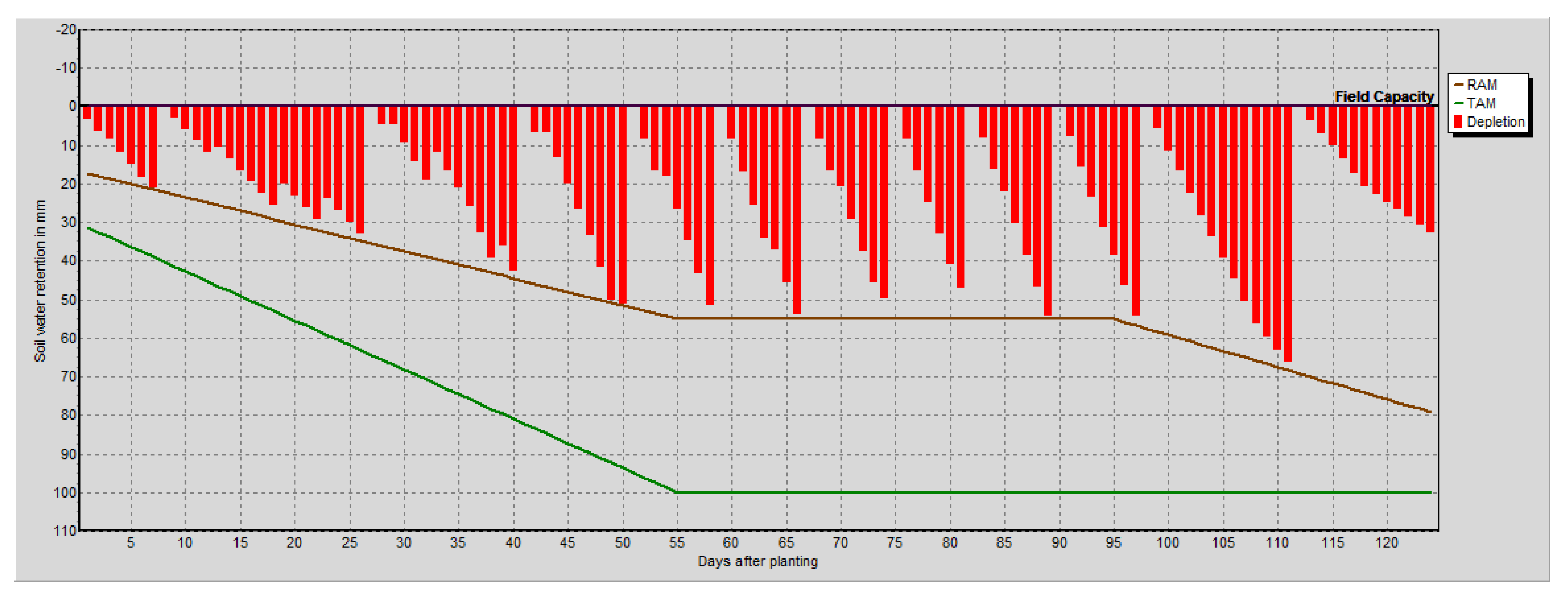1. Introduction
Due to increasing water needs all over the world, water has become a valuable resource in a variety of fields, including agriculture irrigation, hydropower, and water supply [
1]. In many parts of the world, water demands are increasing along with population growth, yet fresh water resources are becoming scarcer. [
2]. The arid climate in the southern Punjab of Pakistan makes wheat, cotton, rice, and sugarcane difficult to grow due to low precipitation rates [
3], limited water, and high evapotranspiration. For planning, building, operating, and managing farm systems, an accurate assessment of crop water requirements (CWR) is necessary [
4,
5,
6]. An accurate assessment of CWR can help to maintain the economically efficient use of water supplies for irrigation. The sustainability of irrigation water is greatly influenced by ET (evapotranspiration) resources [
7,
8].
The CROPWAT model can play a significant role in developing practical recommendations for boosting yield output in conditions of limited water [
9]. The CROPWAT model is used to calculate the water requirements, as well as irrigation planning for important crops, including sugarcane, wheat, cotton, and rice, among others [
10]. It enables the development of recommendations for better irrigation techniques, the management of irrigation schedules under various water utilization needs, and the calculation of productivity under rainfed conditions or shortfall watering [
11]. The expected yield loss is driven by climate conditions and water pressure [
12]. The simulation results suggest that the primary yield reduction occurred in the developing stage in both rainfed and irrigated situations [
13,
14]. CROPWAT software is an important practice used by various scientists for the valuation of CWR and crop evapotranspiration, as well as irrigation scheduling [
15]. These software programs were introduced by the FAO (Food and Agriculture Organization) to identify the CWR and irrigation scheduling and management [
16,
17,
18,
19].
Pakistan has one of the highest population growth rates in the world [
20,
21,
22]. Increasing the population in urban areas being observed worldwide is most striking in developing countries [
23], for example, Pakistan, where several urban centers have sprung up during the last few years [
24,
25,
26,
27]. Previously, a number of studies were conducted on urban growth of some Pakistani districts, e.g., Multan, Lahore and Faisalabad, and these studies have discussed the cities in terms of open spaces, housing types, building density, city layout, as well as functional characteristics [
28,
29,
30,
31,
32]. A region’s cropping patterns are very much affected by the historical, socioeconomic, political and geo-climatic elements [
33,
34,
35,
36,
37].
Since ancient times, Punjab has been referred to as the “land of the five rivers” [
38,
39]. For many farmlands in Punjab, water does not arrive in a timely way or in sufficient quantities to reach the crops [
40,
41]. Because of insufficient levelling, less awareness, as well as poor water management techniques, water is frequently not delivered properly to the flood-irrigated areas in Punjab [
42,
43,
44]. Punjab’s primary user of water is agriculture; hence, irrigation systems need to be managed and modernized effectively by carefully assessing water system requirements [
45]. To meet the demand for irrigation, it is important to understand the crop water required (CWRs), as well as irrigation scheduling. In the current study, using ArcGIS and CROPWAT tools, we analyzed the evapotranspiration (ET) and crop water requirements, as well as the irrigation scheduling of the main crops (cotton, rice, and wheat) in the Multan District of Pakistan.
4. Discussion
The main objective of this research, irrigation water requirement and evapotranspiration for the main crops have been determined using the ArcGIS 10.6 and CROPWAT 8.0 software in Southern Punjab, Pakistan. The relation of freshwater flows and higher temperatures caused by climate change is anticipated to have an influence on both the amount and quality of water [
59]. The water quality of rivers is likely to be negatively impacted by both growing urbanization and climate change. This could have important economic repercussions for the societies that depend on rivers, both directly through their use and indirectly through water-dependent industries such as agriculture.
According to Hussain et al. [
25], rapid expansion in urban areas is often perceived as an indicator of the commercial growth; together, it impacts on environmental services and resources. These effects may consist of a loss of biodiversity, decrease in vegetation area, effect of urban heat island, emissions of greenhouse gases and spatial separation of natural environments, soil, light, water, as well as noise pollution [
37,
41]. According to our study, between 1990 and 2020, there was a significant growth in “build-up area” (increased to 8%). As a result, the findings indicate that urbanization is the form of land use that has the biggest detrimental impact on water quality.
Another perception of drop in agricultural yield is also congruent with scientific research conducted by Schnepf [
60], where they have shown that 1℃ increase in temperature can lead to 3–6% reduction in yield of various crops (e.g., wheat, rice, maize and soybean). The perception of farmers on the change in crop patterns is also in agreement with the ground reality of installing sugar mills in cotton areas of Punjab [
9,
18], which has led to a shift from growing cotton to growing sugarcane. Moreover, the perceived LULC changes are in accordance with recent studies such as Hussain et al. [
21] and Waleed et al. [
21]. These studies have shown that rapid LULC changes are taking place at national and local levels in Pakistan. In the survey, a greater fraction of farmers agrees that climate change can be mitigated. Regarding the rainfall intensity, respondents’ perception is in agreement with local increase in the precipitation in recent years [
61,
62]. However, Wahaj et al. [
63] show that the average rainfall intensity has declined for the whole country over the study period of seven years (i.e., 2010–2017). The perception of the respondent on the decrease in the rainfall events is also corroborated from the data presented by Ewaid et al. [
62], where it is shown that the rainfall frequency has decreased causing an increase in the number of dry days. The study’s findings revealed that
ET0 ranged from 1.8 to 10.24 mm/day, while effective rainfall ranged from 2 to 31.3 mm in the Multan Region. Irrigation requirement for wheat, cotton, and rice were 209.5, 996.4, and 623.2 mm/dec, respectively. Crop water consumption is higher during the dry seasons (autumn and summer) and lower during the wet seasons (spring and winter).
The entire evaluation of this study revealed that the watershed has a water supply and demand disparity. Due to the lack of an effective irrigation committee and water management system, there is also a lot of conflict among users. The usage of conventional irrigation systems, which waste water and reduce water use efficiency, is the other issue in the watershed. Therefore, alternative water supply sources, including water harvesting technologies, should be researched, as well as various agricultural water management solutions should be put into practice in order to overcome the water deficit [
64]. Additionally, alternative irrigation techniques, such as drip irrigation, should be established in the region, and irrigation scheduling should be used to increase the efficiency of irrigation water. There were similar findings from other studies on issues with water management; a lack of water availability and disputes between water users were also revealed. One of the difficulties in allocating water is the water demand brought on by the fast growth of the population and the rising need for agricultural irrigation. As a result of the tremendous demands placed on water resources and their unprecedented effects on socioeconomic development, this rapid rate of increase has serious repercussions. One of the issues in the river basins is a shortage of water. The main causes are the increased demand for fresh water caused by population development, the deteriorated water quality and contamination of surface and groundwater sources, and the loss of prospective fresh water supply sources brought on by outdated and inefficient water management techniques. Conflicts frequently occur when several river users compete for a constrained source of water [
65].
There are other factors involved in water scarcity besides availability. It is a very contentious global problem that some have predicted may lead to the world’s next fatal conflicts, including the vice president of the World Bank. There are connections among many water issues in Northern Africa. Drinking water is frequently in scarce supply, precipitation is infrequent and uncertain, and the current infrastructure causes massive water losses through evaporation. In certain metropolitan locations, inhabitants only receive water once every 3 days. In other regions of the continent, the United Nations believe that patterns of unsustainable water usage, inadequate management, pollution, rising demand, and rapid population increase are to blame for a number of conflicts. According to UN predictions, by 2025, one in two Africans will reside in nations with water shortages [
66,
67]. In irrigation plans in the Southern Punjab Province, there are significant water losses. The majority of the time, earth canals and ditches used to distribute water to farmers’ fields are very badly maintained and suffer significant water loss through flow, infiltration, and leakage.
5. Conclusions
In this study, irrigation water requirement and evapotranspiration for the main crops have been determined using the ArcGIS 10.6 and CROPWAT 8.0 software in Southern Punjab, Pakistan. According to our finding, the build-up area increased, 57,581 Ha (15.78%), as compared to 1990. Urbanization is finished by the expansion of roadways, residences, and commercial and industrial structures. The total net irrigation and total gross irrigation were 72.4 mm and 103.5 mm for cotton, 67.8 mm and 99.8 mm for rice, and 44.1 mm and 63 mm for wheat. A few stream courses were altered to make room for new development. There may be some deep large-capacity wells that industries dig. Since less water will permeate the earth as a result of more pavement, there will be less water available to replenish the subsurface water table. The water table will drop as a result. Several existing wells can dry up because they are not deep enough to draw water from. Evapotranspiration ranged from 1.8 to 10.24 mm/day, while effective rainfall ranged from 2 to 31.3 mm in the study area. Irrigation requirements for cotton, rice, and wheat were 996.4, 623.3, and 209.5 mm/dec respectively. Due to this research area’s seasonal and biological characteristics, it is clear that irrigation scheduling and CWR were unique to the Multan territory. Cotton, the summer crop, required higher evapotranspiration, water, and frequent watering plans than the three main crops in the following order:
The main results of the research increase our information of several important crops in the Multan region’s water needs, which can assist in the improvement of the water resources and yield through advanced technology based on these results. To calculate CWRs for all parts of Pakistan that lack such research, a thorough plan should be created. Additionally, there are no guidelines or regulations for managing the watershed or using the river appropriately. in irrigation plans in the Southern Punjab Province, there are significant water losses. Therefore, alternative water supply sources, including water harvesting technologies, should be researched, as well as various agricultural water management solutions should be put into practice in order to overcome the water deficit. Moreover, various irrigation techniques, such as drip irrigation, should be enhanced in the region to increase irrigation water efficiency. The findings of this research may be employed as a guidance for farmers to choose the quantity and frequency of irrigation for the crops being investigated, as well as by water resource planners for future planning, helping to conserve water in fulfilling the crop water requirements.














